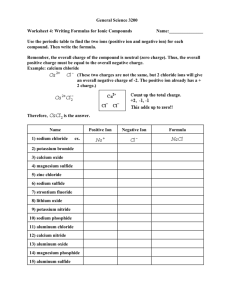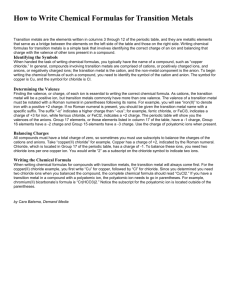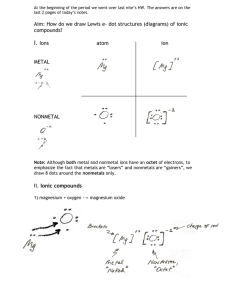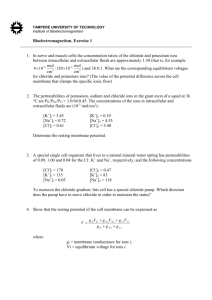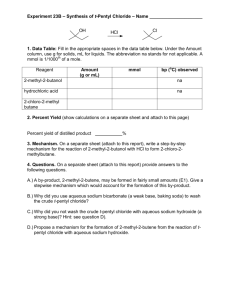Determination of Serum Chloride
advertisement
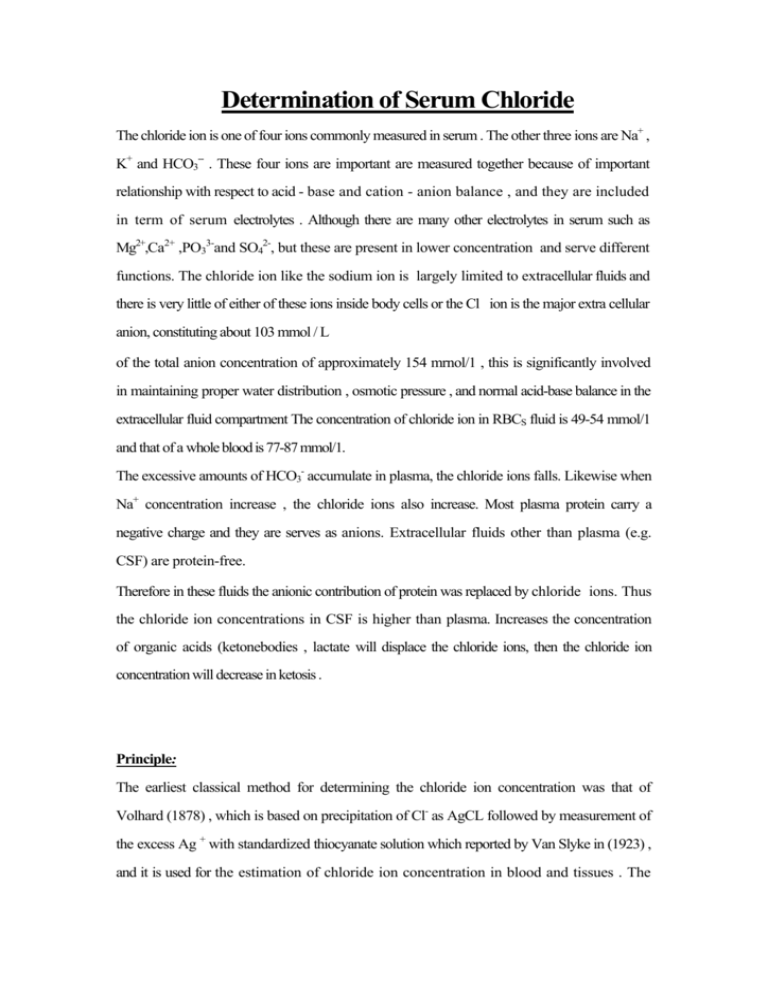
Determination of Serum Chloride The chloride ion is one of four ions commonly measured in serum . The other three ions are Na+ , K+ and HCO3-- . These four ions are important are measured together because of important relationship with respect to acid - base and cation - anion balance , and they are included in term of serum electrolytes . Although there are many other electrolytes in serum such as Mg2+,Ca2+ ,PO33-and SO42-, but these are present in lower concentration and serve different functions. The chloride ion like the sodium ion is largely limited to extracellular fluids and there is very little of either of these ions inside body cells or the Cl ion is the major extra cellular anion, constituting about 103 mmol / L of the total anion concentration of approximately 154 mrnol/1 , this is significantly involved in maintaining proper water distribution , osmotic pressure , and normal acid-base balance in the extracellular fluid compartment The concentration of chloride ion in RBCS fluid is 49-54 mmol/1 and that of a whole blood is 77-87 mmol/1. The excessive amounts of HCO3- accumulate in plasma, the chloride ions falls. Likewise when Na+ concentration increase , the chloride ions also increase. Most plasma protein carry a negative charge and they are serves as anions. Extracellular fluids other than plasma (e.g. CSF) are protein-free. Therefore in these fluids the anionic contribution of protein was replaced by chloride ions. Thus the chloride ion concentrations in CSF is higher than plasma. Increases the concentration of organic acids (ketonebodies , lactate will displace the chloride ions, then the chloride ion concentration will decrease in ketosis . Principle: The earliest classical method for determining the chloride ion concentration was that of Volhard (1878) , which is based on precipitation of Cl- as AgCL followed by measurement of the excess Ag + with standardized thiocyanate solution which reported by Van Slyke in (1923) , and it is used for the estimation of chloride ion concentration in blood and tissues . The electrometric method is based on the exposure of a chloride solution to an electrodes that emit Ag+ ions in an acid medium , The time required for Cl- ions precipitation as AgCl is recorded and is directly proportional to chloride ion concentration. This method was rapid, accurate and sensitive in the estimation of chloride ions in biological samples (1958) . The sample is titrated with a standardized mercuric nitrate solution in the presence of the indicator. Chloride ions in the sample combine with mercuric ion (Hg++) to form mercuric chloride (Hg C12) , a colorless , soluble but only slightly ionized compound . As long as Cl- are present , Hg++ react with them . At the end point, when all the Cl- have been complexes , the excess Hg++ produced a violet color in the presence of diphenyl carbazone. 1. Hg++ + 2Cl ++ 2. Hg HgCl2 + Diphenyl carbazone Violet color (excess) Bilirubin or hemoglobin may obscure the end point. Therefore protein free supernatant should be prepared form hemolyzed specimens. The chloride ion concentration can be determined in plasma, CSF or urine by using this method. Extremely hemolyzed serum should be avoided, because the CL- content of RBCs is about half that of serum and will yield low results. Many laboratories titrate the sample directly with Hg(NO3)2without preparing a protein free. This direct method yield rapid results, but has a disadvantage in which a positive error of approximately 2% owing to the reaction of Hg2+ with –SH group of protein. Clinical Significance: Decreased value of serum chloride is called hypochloremia, which is associated with the following cases: l. Hypoventilation: Inadequate removal of CO2 from the blood by the lungs. This result in the accumulation of ionized carbonic acid in blood, therefore increase in HCO3 - cone, which cause a decrease in chloride ion concentration. (it is excreted into the urine). 2. Diabetic Ketoacidosis : Uncontrolled diabetes results in the accumulation of ketonebodies in serum, which are strong organic acids, so that they displace both Cl- and HCO3-. 3. Lactic acidosis. 4. Chronic diarrhea: Intestinal secretion are also high in CI- concentration, the loss of intestinal secretions over long periods will reduce the total body chloride ions. 5.Vomitting: Gastric secretion are high in chloride ions and large volumes (over 2 liters) are produced and reabsorb daily. Continuous vomiting over long periods results in the loss of chloride ions from the body. 6. Adrenal disease: Both hypo-and hyper-adrenalism are associated with low serum chloride level, because the adrenal gland produces hormone which control fluid and electrolyte balance. 7. Renal failure : Failing kidneys results in the accumulation of PO43- and SO42- which displace serum chloride. 8. pneumonia. 9.Hypokalemic alkalosis. Increased serum chloride levels is called hyperchloremia which are associated with: 1. Hyperventilation: due to a fall in bicarbonate ion concentration. 2. Effect of drugs: Large doses of ammonium or KCL may produce hyperchloremia. 3.Dehydration: Decrease in plasma water caused an increase in serum chloride level. 4. Arterial hypertension. 5. Sulfonamyl diuresis.

